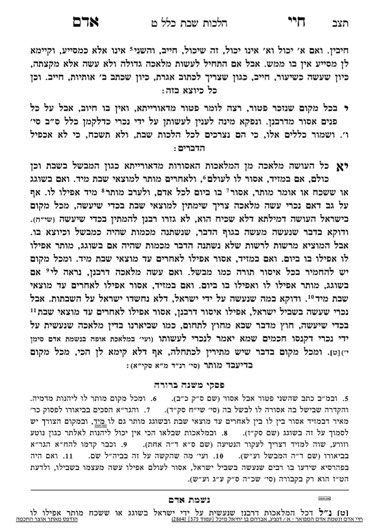Sponsorships for the upcoming Klalim, which discuss the 39 melachos of Shabbos, are available. Please contact Rabbi Reingold for more information at rabbireingold@gmail.com or 301.996.5910
We are continuing in siman 11, discussing the concept of maaseh Shabbos. We have finished the siman, and have a few other points to clarify.
We discussed news, pictures or articles developed on Shabbos. The sefer Orchos Shabbos makes an important point regarding pictures. We learned that the maaseh Shabbos of a person who is mechalel Shabbos is assur bichdei sheyaasu (shiur s302). If so, if a picture is taken of a scene which will not be available after Shabbos, there is no possibility of bichdei sheyaasu, so the item is assur forever. Although the author writes that he did not find any source for this point, he assumed it to be logical, and he asked Rav Elyashiv who concurred to it.
We need to discuss the use of electricity in Eretz Yisroel. The issues in question are the maaseh Shabbos of the Jews or non-Jew who work in the power plants, and the concern for the chilul Hashem when using it. Regarding the maaseh Shabbos, theoretically, if the company is fully automated, there would be no issue of maaseh Shabbos, since all melacha has been set in motion before Shabbos and no one is involved in melacha over Shabbos. Although this scene may be an oversimplification, let us assume as such for our discussion. If so, the primary issue is the workers-many of whom may be Jewish-who are monitoring, adjusting and repairing the system as necessary. About a year ago, an initiative was discussed in the Knesset to create some sort of battery-powered system which would store electricity during the week and could be used over Shabbos.
The argument of those who are lenient is that the electricity is produced automatically, and even though there may be human intervention, that intervention is muttar. The electric grid includes hospitals, senior homes and many other essential functions which must be maintained without fail. Thus, the primary actions are for the purpose of sakanas nefashos, and the individuals who may benefit are merely secondary to these functions. The electricity is not primarily for the individual consumer, and therefore it is muttar to benefit from it.
The argument of those who are stringent is that most essential systems have their own generators. Additionally, any repairs or adjustments are usually minor and non-emergency within the larger grid, and the grid can often redirect electricity in a temporary manner to avoid disruptions.
Additionally, they argue that the Gemara discusses whether the food cooked for a person who is in a state of sakanas nefeshas can be eaten by a person who is not in a state of sakanas nefashos. When it comes to bishul, only the choleh is allowed to eat of the food cooked for him. If others would be allowed to eat rom the food cooked b’heter for the choleh, Chazal were concerned that one may be marbeh bishvilo, one may add extra to the pot for the person who is not choleh. Over here, as well, even though the action is muttar, there is still a concern that one will perform extra melacha for the person who is not sick.
On the other hand, Rav Shlomo Zalman counters that when it comes to shechita, even if all that the choleh needs is a kezayis of meat, it is muttar to shecht the entire animal. There is a sakanah at hand so we do not focus on the concern of marbeh bishvilo, as one maaseh is used for one or many, and it is not possible to help the one without the many. . The same argument can be applied to electricity in that the focus is for the essential institutions, and the reality that others benefit is secondary.
Practically, one should ask their own rav regarding the halacha lemaaseh.
Summary
- Even when maaseh Shabbos of planting was performed b’shogeig, as there is no way to tell that one is refraining from benefit from the melacha, the maaseh Shabbos must be removed. Nevertheless, one may replant it after Shabbos.
- It is unclear whether this concept applies to other melachos. Bedieved, most such cases will be muttar. Either way, the item will be assur bichdei sheyaasu.
- If the melacha was something which cannot be replicated after Shabbos (e.g., a picture of a scene which will not exist after Shabbos), it is impossible to wait bichdei sheyaasu, so it is assur forever.
- The question of maaseh shabbos of a non-shomer Shabbos Jew applies to electricity on Shabbos in Eretz Yisroel. Those who permit its use hold that the electric grid is automated for the most part, and any interventions are used for essential services ( i.e., sakanas nefashos) and personal benefit is secondary; those who hold that it is assur are concerned that this argument is inaccurate. One should ask their rav for practical guidance.


